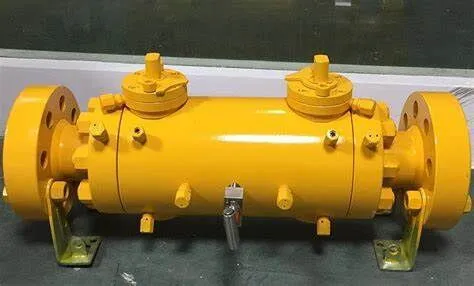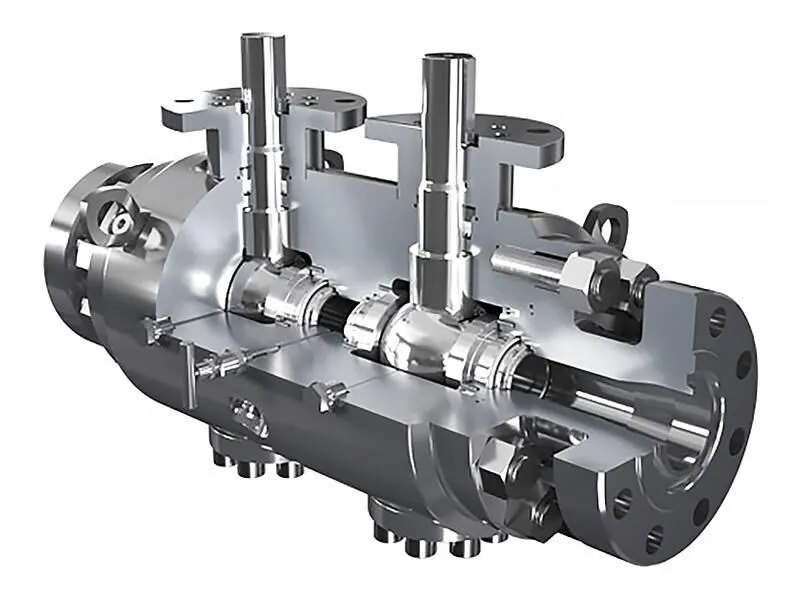
A block and bleed valve is intended to relieve any pressure buildup and isolate particular pipe system segments for maintenance. In order to improve safety, this kind of valve is frequently utilized in sectors like chemical processing, oil and gas, and other industrial applications.
- Block and bleed valves allow for pressure relief while isolating specific pipe segments.
- By obstructing the flow and releasing trapped pressure, they enable safe maintenance.
- Frequently found in chemical, oil and gas, and other sectors that use pressured piping
- Enhances safety by removing pressure accumulation while working.
In order to perform inspections, repairs, or replacements, workers can shut off portions of pressurized piping systems using block and bleed valves. The valves simultaneously offer a regulated "bleed" route for the escape of trapped liquid or vapor between sealed boundaries. By doing this, hazardous pressure buildup during component maintenance is avoided.

What is a Block and Bleed Valve?
A block and bleed valve has a vent or drain in between two sealed borders. The two blocking valves isolate the affected piping segment, and the middle bleed area releases pressure.
Here are the three key components:
Block Valves:
To isolate the pipe segment that need attention, they are closed. They use metal-to-metal contact to close off the line. Ball, gate, and globe valves are frequent choices. Double isolation is produced by two block valves.
Bleed Valve:
Liquids or vapors from the area between the two closed block valves are vented by the bleed valve in the middle. This removes any accumulation of pressure. Typical bleed options include globe, ball, and needle valves.
Vent/Drain:
This outlet line permits the safe release of gas or liquids from the bleed valve. usually a straightforward vent stack or drain pipe. guarantees ongoing pressure relief.
Types of Block and Bleed Valves
Depending on the number of block valves and isolation needs, there are a few distinct block and bleed valve configurations:
Single Block and Bleed Valve
One block valve is located on each side of the bleed valve in the simplest arrangement. This isolates the pipe segment being worked on by creating a single sealed boundary on each side.
Double Block and Bleed
Two block valves are located on either side of the bleed valve in a double block and bleed valve. To further prevent leaks, it forms double-sealed borders. Any leaking beyond the first block can be evacuated through the gap between the DBB valves.
Double Isolation and Bleed Valve
This offers double block and bleed isolation on both sides with two block valves on each side and a bleed valve in between. Although it is the most costly and complicated choice, it is also the most leak-proof.
Increasing degrees of protection against leaks and pressure building are offered by the different block and bleed valve combinations. Facilities select the type according to cost, safety regulations, and service severity.
Benefits of Using Block and Bleed Valves
Block and bleed valves are an essential component of many industrial piping systems because of their numerous significant advantages:
- Improved Safety
The primary benefit is the ability to safely work on pressurized systems while partially shutting them down. Employees are shielded from hazardous pressure buildup or releases.
- Leak Reduction
By isolating only the area that requires maintenance, block and bleed valves reduce the number of possible leak locations. They use double seal barriers as well.
- Operational Flexibility
To maintain piping components, plant operations don't need to be completely stopped. Only one section can be blocked off using block and bleed.
- Emission Control
Hazardous liquids or vapors are contained by carefully venting and sealing off portions of pipes. Uncontrolled discharges into the environment are avoided as a result.
- Reliability
The risk of valve failures is decreased by the redundant sealing and bleed capabilities. With minimal downtime, plants can maintain their pipes.
Applications of Block and Bleed Valves
Industrial establishments that use pressured pipe systems now frequently use block and bleed valves. Among the most widely used applications are:
- Oil refineries – Makes it possible to safely separate and operate on portions of the pipework used in the hydrocarbon process. need for services that are exceedingly dangerous.
- Natural gas plants –Used throughout gas transmission infrastructure to prevent emissions into the atmosphere while facilitating maintenance and securing off areas for inspection.
- Chemical plants – Vital for avoiding hazardous intermixing and maintaining reactor pipe systems. used to reduce emissions as well.
- Offshore platforms – Granting secure access to risers and subsea pipes in spite of high pressure. reduces the dangers to employees.
- Power plants – Permits boiler, turbine, and steam line maintenance without affecting operation. crucial for the dependability of the plant and employees.
- District heating – To replace parts and perform repairs without affecting service, portions of the hot water distribution piping are isolated.
Block and bleed valves are standard components for any application involving pressured piping that needs routine maintenance, such as underground mining or liquefied gas carriers, due to their capabilities. Without them, performance and safety would suffer.
Conclusion
Block and bleed valves are essential in industrial settings because of their special capacity to isolate pipe sections while securely bleeding trapped pressure. Pipe maintenance and component replacement would be very challenging, dangerous, and disruptive without these specialized valves.
Block and bleed valves provide continuous operations, worker safety, and environmental stewardship. The benefits of decades of dependable service outweigh the higher initial cost of their redundant sealing construction. When it comes to maintaining safety when working on pressurized systems, there is no other option.
